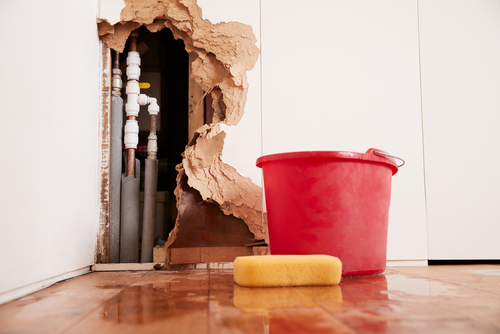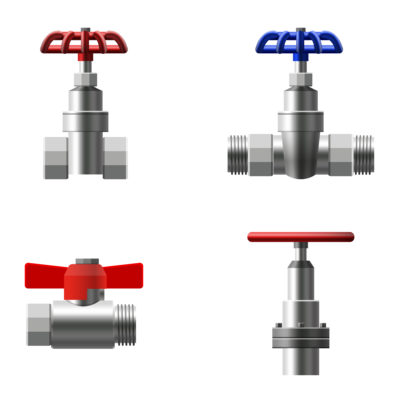
The first deep freeze of the year is right around the corner. Cold weather brings several hazards, including frozen pipes which can lead to devastating repairs. Not to mention, this is a massive inconvenience for both tenants and landlords. That means as an owner, ensuring tenants have properly winterized the property should be a top priority. But, do your tenants know what to do to avoid burst pipes? If not, this article will walk you through the process of preparing a rental for the changing seasons and incoming cold weather.
What Causes Pipes to Burst in Winter?
If asked what causes burst pipes in winter, many landlords would answer, “ice.” However, the science behind this costly maintenance emergency in your rental is a bit more involved.
As water freezes, the molecules expand into a hexagonal form which takes up more space than its liquid counterpart. That said, this expansion forces the remaining water in the pipe towards the closed faucet. Thus, creating immense pressure, which can eventually cause the pipe to rupture. The most vulnerable pipes in any rental home include –
- Outdoor Hose Bibs
- Pipes Along Exterior Walls
- Water Sprinkler Lines
- Swimming Pool Supply Lines
- Supply lines in Unheated Areas (such as the basement, garage, attic, under cabinets, or crawlspace)
Steps to Shutting Off Exterior Water to Avoid Burst Pipes
As the temperature drops, landlords and tenants must work together to winterize exterior pipes. This involves locating, turning off, and draining hose bibs or other pipes vulnerable to the elements. Thankfully, the process is quite simple and can be accomplished in 4 simple steps.
- Locate Exterior Faucets
- Find the Shut Off Valves
- Turn Off the Exterior Water Supply
- Bleed the Lines
Locate Exterior Faucets
Step one is to take note of all exterior hose bibs or exterior faucets. If not already familiar with their location, take some time to walk around the home’s perimeter carefully. If hoses were still attached, ensure those are removed, drained of any lingering water, and properly stored away for the season.
Find the Shut Off Valves
Once you locate all exterior faucets, it is time to head back inside and find the exterior shut-off valves. These valves may be near the main water shut-off or along the basement ceiling, depending on the individual property. While location can vary, exterior supply shut-off valves can be easily traced to the home’s outside walls.
 Turn Off the Exterior Water Supply
Turn Off the Exterior Water Supply
Shut off the water supply to any exterior faucet, keeping in mind; there may be more than one. Typically, newer homes have a lever-style valve that incorporates a bleed cap. Thus, helping to further drain away any residual water in the pipe. However, older homes may be a different story. So, depending on the type of valve you have, follow these shut-off instructions below –
- Gate Valve – Gate valves utilize a round handle similar that works by lifting or lowering a barrier into the path of water flowing through the pipe. So, to close the valve, turn the handle clockwise several times until you feel the gate fully engage. Thus, closing off the water supply.
- Ball Valve – A ball valve has a straight pivoting handle and is common in newer homes. These operate by pivoting a hollow ball as the handle turns to restrict water flow. So, to close the valve, turn the handle a quarter turn, so it is perpendicular to the pipe.
Pro Tip: Valves that do not receive a lot of use or are old can be fragile. Therefore, turn them carefully and slowly to avoid damage.
Bleed the Lines
Just because the water supply is now turned off does not mean landlords and tenants are in the clear. So, to further avoid burst pipes, head back outside and open the faucets. Then, go back inside and place a bucket below the valve before opening the bleeder cap. By completing these two steps, any remaining water can drain from the pipe. Once you are confident, no water remains, replace the cap and close the exterior faucet.
Tips to Avoid Frozen Pipes Throughout Your Rental
No landlord or property manager ever wants to get the emergency call for frozen or burst pipes. That said, it is no fun for tenants either. That is why taking proper steps early in the season will help ensure these emergencies, and their subsequent repair bills, do not occur. In addition to avoiding frozen pipes by shutting off the exterior supply, check out these other tips.
- Purposefully Dripping Faucets – Extreme temperatures threaten pipes throughout a rental home, especially if it is vacant. Therefore, consider allowing a small amount of water to drip from faucets and tubs when temperatures fall below freezing. However, just be sure there are no clogged drains.
- Maximize Airflow – Under-sink pipes are especially susceptible to freezing as they are tucked away in cold cabinets. So, when temperatures are particularly low, open cabinet and vanity doors to allow warm air to circulate and help avoid frozen pipes.
- Insulate Exposed Pipes – Pipes along the exterior or outside-facing walls face the most significant risk of succumbing to bitterly cold conditions. So, take the time to wrap vulnerable pipes in insulating foam to help keep them protected.
- Set the Thermostat – In order to avoid frozen and burst pipes, ensure the tenant sets the thermostat to a minimum of 55 degrees.
The First Signs of a Frozen Pipe
As with any maintenance emergency, quickly assessing the situation and jumping into action is critical. That said, do your tenants know who to contact if an after-hours emergency occurs? To minimize potential damage when burst pipes occur, ensure tenants know the warning signs below –
- No Water Flow – If water is not coming out of any bathroom or kitchen fixtures, this is a bad sign! So, when there is little to no water flow, tenants should immediately notify the landlord.
- Frost on the Pipe – When temperatures plummet, tenants should keep an eye on any exposed pipes for signs of frost. This accumulation of frost could signal a problem in the pipes and requires further attention.
- Sudden Odd Smell – Oddly enough, a sudden or strange smell emanating from a drain could signify that the pipe is clogged. While this alone does not signal frozen pipes, tenants should look for additional warning signs and alert the landlord.
When the warning signs above occur, tenants and landlords must work together to address the concern efficiently. This quick action can help contain the problem before leading to burst pipes and potentially prevent further, more costly, damage.
Will Insurance Cover Burst Pipes?
Addressing damage from burst pipes can be costly for landlords as repairs can range from a few hundred to a few thousand dollars. So, you may be wondering, will my insurance cover the damage?

Typically, the answer is both yes and no. Insurance companies do not cover the pipe repair cost but will often cover other damages to the surrounding area (furniture, walls, or flooring). That said, there are a few essential things to remember –
- Know Your Policy – Every company and policy may offer different coverage limits and exclusions, including water damage. So, the best way to know if you are covered is to read the policy carefully and reach out to your insurance professional with any questions.
- Avoid Negligence – Regardless of what insurance provider landlords have, damages caused by negligence are unlikely to be covered. Therefore, take all necessary steps to avoid or mitigate damages resulting from burst pipes.
- Require Renters Insurance – A landlord’s policy does not cover damage to tenants’ personal belongings due to burst pipes. That said, a renter’s policy will! Nowadays, requiring tenants to purchase a renters policy with liability protection has become industry standard. In addition, this typically costs around $8 to $15 per month, making it relatively affordable.
Protect Your Property with Professional Management
When it comes to avoiding costly repairs, including those for burst pipes, preventative maintenance is vital. However, for landlords, managing multiple rental properties along with all of their seasonal inspections can be a challenge. Fortunately for rental owners, professional property managers can assist by taking over the daily operations and freeing up valuable time.
The experts at Bay Property Management Group proactively ensure tenants are familiar with maintenance procedures, understand their responsibilities, and know the important warning signs to look for. Our 24/7 emergency maintenance line and extensive list of trusted vendors provide peace of mind that we can handle any issue at any time. In addition to maintenance, professional property managers handle marketing, leasing, accounting, rent collection, and customer service. So, if you own a rental property and would like to learn more about the benefits of professional management, give us a call today.

 Turn Off the Exterior Water Supply
Turn Off the Exterior Water Supply